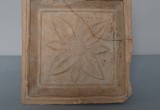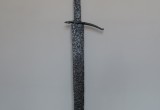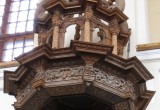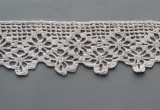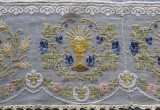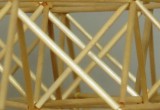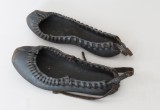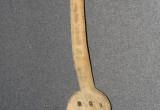For the first time activity of artisans in Kėdainiai in historical sources is mentioned in the beginning of the 16th century. Until the grant of the Magdeburg Law in 1590, Kėdainiai was not only an important administration, religious and culture, but also commercial and crafts centre and had all main features of a town.
In 1585 the town’s owner Jan Kiszka approved provisions of the town’s shoemakers that were used by shoemakers’ guild of Kaunas. The manor of Kėdainiai took care to to pull in merchants and artisans from other places. This way it was expected to make the town more viable. In 1627, the town’s owners Krzysztof and Anna Radziwills ensured freedom of travel to newcomers merchants and artisans. During this period new suburbs with market squares were planned out. In this period in the town there were 6 market squares. Next to the one of them – the Big Market Square, in the middle of the 17th century, a house of merchants Jacob and John Arnets was built. At the present time the House is one of the Museum departments, a Centre of Crafts for research and popularization of the town’s history and culture.
The virtual museum presents a lot of crafts, practiced in Kėdainiai guilds and outside them. Times changed and crafts did also, some of them disappeared, some came into being, therefore the chronological limits of the Museum span the period of fishermen settlement of the 14th century and works of artisans of the end of the 20th century, re-creating the ancient crafts. All exhibits are from collections of the Museum and its branches. The biggest part of items being kept in the Museum got there from places that were or still are within limits of Kėdainiai district. Nevertheless, geography of origin of such items sometimes is very wide or it is difficult to determine it. Very often, it is impossible to determine an authorship of items, made even before the end of the 19th century.
Visitors of the virtual museum will get detailed information about two collections being kept in Kėdainiai Regional Museum. The collection of archaeological artefacts is presented by production of artisans, whose chronological limits span the 14th–19th centuries. Mostly, there are fragments of pottery or reconstructions, samples of smithery, turnery and products from bone. These items were found in the cultural layer of Kėdainiai old town, in sites of ancient cemeteries and hill-forts. Some artefacts were found and given to the Museum by local residents. The particularity of artefacts, their selection and succession is based on variety and evolution of crafts from the 14th to 19th centuries, when industrial revolution terminated existence of guilds.
The craft of potters of the 14th century is presented by smart decorated ceramics, made by common villagers. The variety of ceramics of the 15th century, shapes and ornaments testifies about presence of this craft in Kėdainiai. The craft of potter was elaborated in the 17th century – resulted in glazed pots, plates and tiles. Rich residents of the town could obtain tiles of various shapes and decorations. When smokimg came into fashion, potters started to produce fine pipes, that also are presented in the virtual exposition.
The products of turners are presented by bone buttons, medical instruments and products of unprosecced bone with cuts. The textile craft in Kėdainiai of the 14th century is presented by spindles of sandstone, made by local artisans and spindles of reddish slate, brought by merchants.
The precision goldsmiths is presented by various brass rings and buckles. The smithery is presented by tools used in the household of the 14th century – knives, axes, keys, ice-picks. Swords, chain-mail and details of horse gear tell about battles against the Teutonic Order. The smithery of further ages is presented by cross-suns, fittings, locks and other ware. In the exposition there are samples of foundry craft and metalworkers: sarcophaguses, armours, bells made from the 16th till the end of the 19th centuries.
The collection of wooden items is divided into eras from the 15th to 21st centuries, works created in this period represent topicalities of religious, spiritual and social life of societies. The exposition shows a part of valuable collection of monumental crosses made by an artist V. Svirskis in the 19th–20th centuries and now being kept in the Museum, as well as samples of the little plastic art – small sculptures of saints. The carving stylistics of the 2nd half of the 20th century is presented by ideological samples of the Soviet propaganda. The plastic art of wood of the 20th–21st centuries is mostly reprtesented by other collection, being kept in the Museum – sculptures by V. Ulevičius. Skills of artists of Kėdainiai region wouldn’t be fully reflected without demonstration of other wooden ware. The exposition shows items of the daily use made by artisans of various crafts: coopers, clog makers, woodworkers, cabinetmakers. Such items are buckets, pails, clogs, tools of household, that at the same time also had a function of national decoration – plates, boxes, distaffs.
Other crafts, without which the daily life is unthinkable are not forgot either. Kėdainiai town ant its surroundings were famous for its wicker workers, who used make baskets, panniers, punnets. The exposition shows a variety of straw ware, from wicker bins, boxes, seedlips and shoes to baubles for Christmas Tree made using a complex technique. The exposition also presents a craft of a saddler, who used to sell their products in every market – harness, naginės (traditional leather shoes) or bells, that at the present time can be seen only in exclusive expositions.
The third and the biggest group of exhibits are products of textile. The diversity of their expression is reflected by samples of weave, crochet, embroidery and knitting. Often, one spread or slip present skills of several textile crafts: weave, sewing and embroidery. In order, that such product could reach a user, from the beginning of the product’s material preparation, it was necessary to use tools made by artisans of several crafts. Woodworkers, turners, spining wheel makers, blacksmiths and metalworkers used to make various tools, spinning wheels, rollers for weave and other many tools. Some of them, that many years served in producing various household items or food products, are presented in the virtual exposition.

